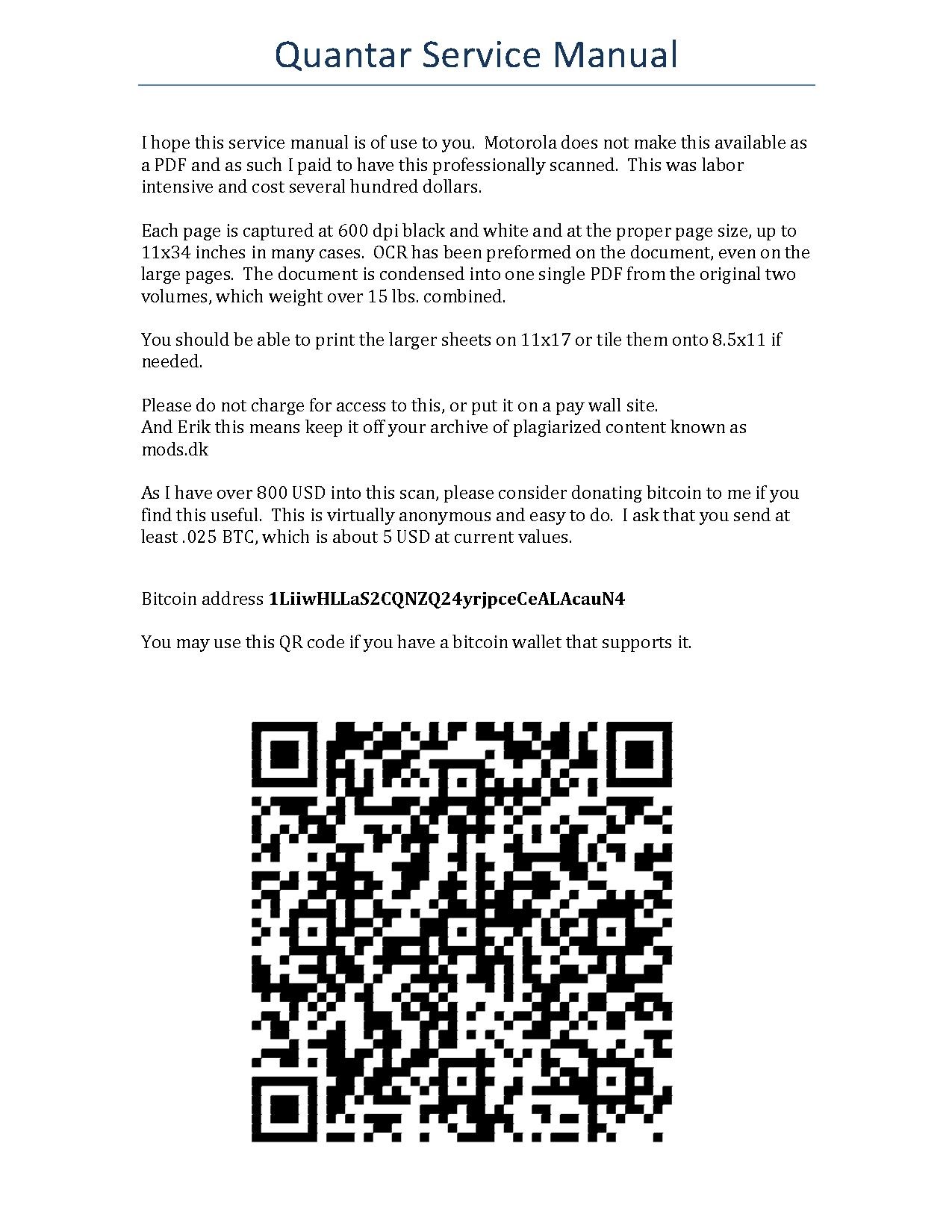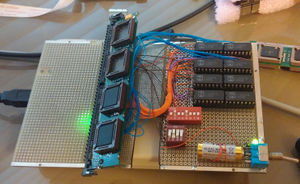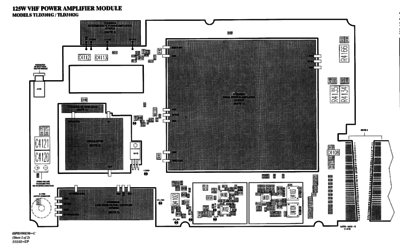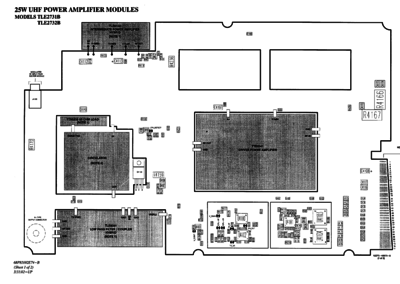Difference between revisions of "Quantar"
| Line 201: | Line 201: | ||
|- | |- | ||
| TLE5974 || CLE1220 || TLN3376 || UHF R4 || [[UHF Exciter|UHF Exciter 490-520 MHz]] | | TLE5974 || CLE1220 || TLN3376 || UHF R4 || [[UHF Exciter|UHF Exciter 490-520 MHz]] | ||
| + | |- | ||
| + | | TLF6920 || CLF1510 || TLN3307 || 900 || [[800 MHz Exciter|800 MHz Exciter 850-870 MHz]] | ||
|- | |- | ||
| TLF6930 || CLF1520 || TLN3308 || 900 || [[900 MHz Exciter|900 MHz Exciter 935-941 MHz]] | | TLF6930 || CLF1520 || TLN3308 || 900 || [[900 MHz Exciter|900 MHz Exciter 935-941 MHz]] | ||
Revision as of 17:07, 25 August 2016
Quantar/Quantro info
There is a bunch of info here about the technical aspects of the Quantar Stations.
The info on the modification and changing ranges of the various modules is on the respective pages. There is some conversion info below, but it's being migrated and reformatted under the respective pages. I feel this is more logical.
If you find anything to be wrong here, please feel free to make an account and change it. I've had to lock down account creation, so you'll need to have it approved. If you want to email me directly, my email is bryan@bryanfields.net
Programming
Links to programming stuff
CSS 007.13.R022.0035 for EPIC4 Smart Zone SCM
WinRSS 14.08.01 Current Windows RSS
Firmware
The newer SCM modules can be upgraded via SLIP connection over the tty port, or via IP over the 10Base2 connector (anyone have a hub?).
The Wireline typically will upgrade during this too, unless it has the older EPROM memory. At that point you'll have to swap the chips.
The exciter is still a hard chip swap upgrade, but programed EPROM's are $20 shipped on eBay. Unless you have more than a few to upgrade it's not cost effective to buy the programer and chips yourself.
SIMM Images
Conventional Firmware for U1-U4 on the SIMM module 20.14.048
IntelliRepeater (IR) Firmware for U1-U8 on the two bank SIMM module 20.14.520
Hacking info
How to combine the firmware into a single binary image srec_cat -Output 20.14.038-SIMM.bin -Binary \ "U4.bin" -Binary -unsplit 4 0 \ "U3.bin" -Binary -unsplit 4 1 \ "U2.bin" -Binary -unsplit 4 2 \ "U1.bin" -Binary -unsplit 4 3 srec_cat -Output 20.14.048-SIMM.bin -Binary \ "20.14.048 - epic 2 - u4.bin" -Binary -unsplit 4 0 \ "20.14.048 - epic 2 - u3.bin" -Binary -unsplit 4 1 \ "20.14.048 - epic 2 - u2.bin" -Binary -unsplit 4 2 \ "20.14.048 - EPIC 2 - U1.bin" -Binary -unsplit 4 3 How to Split it back into a per chip image. srec_cat 20.14.048-SIMM-920mhz.bin -Binary -split 4 0 -Output U4-920.bin -Binary srec_cat 20.14.048-SIMM-920mhz.bin -Binary -split 4 1 -Output U3-920.bin -Binary srec_cat 20.14.048-SIMM-920mhz.bin -Binary -split 4 2 -Output U2-920.bin -Binary srec_cat 20.14.048-SIMM-920mhz.bin -Binary -split 4 3 -Output U1-920.bin -Binary 0x00000 is the start of boot1 0x40000 is the start of boot2 BEBE CAFE BEBE CAFE then object name FEED BEEF FEED BEEF is the end then 4 bytes EEnd of ROM 0x80000 is the start of sc.o 0018FC54 is the start of wl.o
Wireline Images
Wireline 20.10.816 for AT27C010 Chips. This works with the 20.14.048 Conventional Firmware
Exciter Images
This is the matching Exciter Image for a AM27C512 UV EPROM
Code Plug format
Manuals
Hardware info
Part numbers
Here are part numbers and what the correspond to
Station Control info
Station Control Module or SCM is the heart of the Quantar station. The SCM comes in different revisons known as EPIC.
- EPIC I - TTN4094
- EPIC II
- EPIC III
- EPIC IV - This is only for the Smart Zone trunking. IT will not work for conventional
- EPIC V
The only difference between the various versions of the EPICs (excluding EPIC IV) is the hardware is newer. There is no difference in functionality for conventional analog/astro/P25 operation.
SIMM info
The SIMM used for firmware in the Quantar EPIC 2/3 is an 80 pin SIMM and is basically unobtanimum. It is possiable to use a Motorola Console Operator Interface Module SIMM if you want to modify it.
The conventional uses 4, 29F040 chips arranged to be 32 bits wide. This means each chip stores every 4th byte.
Example we store "QUANTAR MOTOROLA" in the SIMM
| Chip 1 | Chip 2 | Chip 3 | Chip 4 |
|---|---|---|---|
| Q | U | A | N |
| T | A | R | |
| M | O | T | O |
| R | O | L | A |
So if we read Chip 1 we'd see QTMR.
The IR uses a two bank SIMM with the same layout (8 chips total)
It's possible to pull these chips and read/write them if you have the right programmer. Taking advantage of this I was able to build a SIMM programmer for the soldered in place SIMM's that essentially programs one chip at a time (8bits).
It's not pretty but it works.
The SIMM has the ability to be upgraded via the SCM download procedure, but the IR SIMM and NON-IR SIMMs cannot be interchanged. This is do to the boot code being different. Using the SIMM programmer or the socketed SIMM you can reprogram the SIMM's for either.
Receiver
Like the rest of the unit the receivers are frequency dependent and consist of their own modules. The basic receiver has a preselector which is 4 MHz wide on VHF and 6 MHz wide on UHF.
The receiver is an excellent high side injection design (exception for 800/900 which is low side). The first IF is +21.45 MHz on VHF and +73.35 MHZ on UHF/800/900. The second IF is 455 KHz. In many cases barefoot (minus preselector) the receiver sensitivity is under .112μV (-126 dBm) for 12 dB SINAD. Couple this with the great built in selectivity and it's truly a bullet proof design idea for high RF sites.
The receiver is pretty dumb, there is not a μP on the board, making it easier to troubleshoot. The devices receive their programming from the main CPU on the SCM via SPI bus. The two main chips are the U2500 receiver IC and U2401 PLL IC. U2401, the PLL, is a custom chip responsible for locking the VCOs to the proper frequency, and selecting the high or low VCO. U2500, the receiver IC, contains the 2nd IF/VCO and final processing of the intended signal. Unlike other designs, the receiver IC presents the recovered audio/data as two digital signals to the SCM where A/D conversion happens (if needed).
There are a couple other chips which present various
UHF R0 was added later and extends the coverage and tuning range of the unit down to 380 MHz. The preselctor for this covers the whole range as well.
Each item has more information on it's own page and covers conversions there as well.
| Svc Man P/N | CLD | FRU P/N | Range | Preselector | Description |
|---|---|---|---|---|---|
| TRD6361 | CLD1250 | TLN3250 | VHF R1 | TFD6511 | VHF Receiver 132-154 MHz |
| TRD6362 | CLD1260 | TLN3251 | VHF R2 | TFR6512 | VHF Receiver 150-174 MHz |
| CRX4022 | CRX1027 | DLN1215 | UHF R0 | CRX4001 | UHF Receiver 380-433 MHz |
| TRE6281 | CLE1190 | TLN3313 | UHF R1 | TLE5991 | UHF Receiver 403-433 MHz |
| TRE6282 | CLE1200 | TLN3314 | UHF R2 | TLE5992 | UHF Receiver 438-470 MHz |
| TRE6283 | CLE1210 | TLN3373 | UHF R3 | TLE5993 | UHF Receiver 470-490 MHz |
| TRE6284 | CLE1220 | TLN3374 | UHF R4 | TLE5993 | UHF Receiver 490-520 MHz |
| TRF6551 | CLF1530 | TLN3315 | 800 | N/A | 800 MHz Receiver 806-825 MHz |
| TRF6552 | CLF1540 | TLN3316 | 900 | N/A | 900 MHz Receiver 935-941 MHz |
Exciter
The exciters contain their own CPU which communicates with the SCM over a SPI bus. This CPU runs it's own firmware and requires a socketed UV EPROM to upgrade it. This also controls the PA meeting and the bit of EEPROM in the CPU stores the alignment settings for the exciter and PA. Generally a Exciter/PA pair will not need to be realigned if moved from one chassis to another, although it should be checked.
| Svc Man P/N | CLD | FRU P/N | Range | Description |
|---|---|---|---|---|
| TLD9831 | CLD1270 | TLN3252 | VHF R1 | VHF Exciter 132-154 MHz |
| TLD9832 | CLD1280 | TLN3253 | VHF R2 | VHF Exciter 150-174 MHz |
| CLX4000 | CLX1000 | DLN1214 | UHF R0 | UHF Exciter 380-433 MHz |
| TLE5971 | CLE1230 | TLN3305 | UHF R1 | UHF Exciter 403-433 MHz |
| TLE5972 | CLE1240 | TLN3306 | UHF R2 | UHF Exciter 438-470 MHz |
| TLE5973 | CLE1210 | TLN3375 | UHF R3 | UHF Exciter 470-490 MHz |
| TLE5974 | CLE1220 | TLN3376 | UHF R4 | UHF Exciter 490-520 MHz |
| TLF6920 | CLF1510 | TLN3307 | 900 | 800 MHz Exciter 850-870 MHz |
| TLF6930 | CLF1520 | TLN3308 | 900 | 900 MHz Exciter 935-941 MHz |
Troof Table
There is a ID code representing the exciter type, it consists of R3700 to R3710. These are either pull up or down resistors on a 6 bit code and are identified on the schematic on the left side of U3700, the μP. Below is the table in MSB-LSB format, with a 1 being high (5v) and a 0 being a low (0v).
| Dip switch! | Band! | Binary! | Notes in the RSS! |
|---|---|---|---|
| 0 | VHF_R1 | 000000 | |
| 1 | VHF_R2 | 000001 | VHF R2 SL |
| 2 | UHF_R1 | 000010 | |
| 3 | UHF_R2 | 000011 | |
| 4 | 800 | 000100 | |
| 5 | VHF_R3 | 000101 | sl |
| 6 | VHF_R4 | 000110 | |
| 7 | VHF_R1 | 000111 | |
| 8 | VHF_R2 | 001000 | VHF R2 FL |
| 9 | VHF_R3 | 001001 | |
| 10 | VHF_R4 | 001010 | |
| 11 | 900 | 001011 | |
| 12 | UHF_R3 | 001100 | |
| 13 | UHF_R4 | 001101 | |
| 14 | blank | 001110 | |
| 15 | blank | 001111 | |
| 16 | blank | 010000 | |
| 17 | blank | 010001 | |
| 18 | blank | 010010 | |
| 19 | blank | 010011 | uhf r0 from book |
| 20 | blank | 010100 | |
| 21 | blank | 010101 | |
| 22 | blank | 010110 | |
| 23 | blank | 010111 | |
| 24 | blank | 011000 | |
| 25 | blank | 011001 | |
| 26 | blank | 011010 | |
| 27 | blank | 011011 | |
| 28 | blank | 011100 | |
| 29 | blank | 011101 | |
| 30 | blank | 011110 | |
| 31 | blank | 011111 | |
| 32 | blank | 100000 | |
| 33 | blank | 100001 | |
| 34 | blank | 100010 | |
| 35 | blank | 100011 | |
| 36 | blank | 100100 | |
| 37 | blank | 100101 | boot |
| 38 | blank | 100110 | |
| 39 | blank | 100111 | |
| 40 | blank | 101000 | |
| 41 | blank | 101001 | |
| 42 | blank | 101010 | |
| 43 | blank | 101011 | |
| 44 | blank | 101100 | |
| 45 | blank | 101101 | |
| 46 | blank | 101110 | |
| 47 | blank | 101111 | "RSS only" |
| 48 | blank | 110000 | |
| 49 | blank | 110001 | |
| 50 | blank | 110010 | |
| 51 | blank | 110011 | |
| 52 | blank | 110100 | RAP says VHF_R2 SL |
| 53 | blank | 110101 | |
| 54 | blank | 110110 | |
| 55 | blank | 110111 | |
| 56 | blank | 111000 | |
| 57 | blank | 111001 | |
| 58 | blank | 111010 | |
| 59 | blank | 111011 | |
| 60 | blank | 111100 | |
| 61 | blank | 111101 | |
| 62 | blank | 111110 | |
| 63 | INVALID | 111111 | Exciter is in reset all LED's are on and the PA fans turn on |
Power Amp
The power amps are actually a cool design.
Their are two basic power amps, a 25W, and a 100/110/125w (depending on band). The power amps all use the same general board layout, with the frequency dependent parts separate from the support components. The 25W PA is a passively cooled unit with a massive heatsink, while the 100/110/125W unit has active cooling with a horizontal heatsink and two cooling fans moving air front to back.
There are a couple different revisions of the PA's so the main PCB has changed a bit over time.
[[|thumbnail|center]]
The PA doesn't contain any CPU, it's controlled via the exciter CPU with basic analog level lines going over to the exciter. Some of what's measured by the exciter
- Intermediate PA drive level - this is the output of the IPA to the final PA pallet
- Driver PA Level - output of the final PA before the circulator (FPA_DETECT).
- TX Power Forward - Output measured at the output of the Low Pass Filter
- TX Power Reverse - Reflected Power from the antenna port
- OMNI voltage - this is the control voltage on the IPA which comes from the SCM as a 0-5V control signal (V_CONT). This 0-5v controls a transistor making a 0-14v signal to provide the gain of the IPA. This is the basis of the power control. The Control Voltage from the SCM is only present during keydown.
- IPA Current detect
- DPA Side A & B current sense
- Temperature of the PA
- Fan on/off and alarm
- PA_ID bits A & B - resistor divider that programs to reference voltages in .5v increments to ID the PA hardware to the exciter.
All these are measured over an TDM bus that selects each at a 200ms interval using a single analog input on the exciter CPU.
PA types
| Svc Man P/N | Other P/N | Rated Power | Range | Description |
|---|---|---|---|---|
| CTX1146 | DLN1216 | 110 | UHF R0 | Second Generation UHF PA 380-433 MHz |
| TTE2061 | TLN3444 | 110 | UHF R1 | First Generation UHF PA 403-433 MHz |
| CLE6164 | Example | 110 | UHF R1 | Second Generation UHF PA 403-433 MHz |
| TTE2062 | TLN3446 | 110 | UHF R2 | First Generation UHF PA 438-470 MHz |
| CLE6165 | CLE1308 | 110 | UHF R2 | Second Generation UHF PA 438-470 MHz |
| TTE2063 | 110 | UHF R3 | First Generation UHF PA 470-490 MHz | |
| TTE6373 | 110 | UHF R3 | Second Generation UHF PA 470-490 MHz | |
| TTE2064 | 100 | UHF R4 | First Generation UHF PA 490-520 MHz | |
| TTE6374 | 100 | UHF R4 | Second Generation UHF PA 490-520 MHz |
| PA Type | PA_ID_A | PA_ID_B | R4162 | R4163 | R4164 | R4165 | Official? |
|---|---|---|---|---|---|---|---|
| 900 100W | 3.0 | .5 | 20.5k | 10k | 1k | OPEN | YES |
| 800 100W | 0.5 | 1.0 | OPEN | 0 | 1.5K | 15K | YES |
| 800 20W | 0.0 | 1.0 | OPEN | 1k | 1.5K | 15K | YES |
| UHF 110W R0 | 0.0 | 1.5 | OPEN | 0 | 390 | 1k | YES |
| UHF 110W R1 | 1.0 | 0.5 | 15k | 1.5k | 560 | 10k | YES |
| UHF 110W R2 | 1.5 | 0.5 | 1k | 390 | 100 | 1k | YES |
| UHF 110W R3 | 3.0 | 1.0 | 2.2k | 2.7k | 1.5k | 15k | YES |
| UHF 100W R4 | 3.5 | 1.0 | 18k | 15k | 1.5k | 15k | YES |
| UHF 25W R1 | 5.0 | 0.0 | 33.2k | OPEN | 0 | OPEN | YES |
| UHF 25W R2 | 0.0 | 0.5 | OPEN | 0 | 1k | OPEN | YES |
| VHF 125W R1 | 3.0 | 0.0 | 20.5k | 10k | 0 | OPEN | YES |
| VHF 125W R2 | 0.0 | 0.0 | OPEN | 0 | 0 | OPEN | YES |
| VHF 25W R1/R2 | 4.5 | 0.0 | 12k | 68k | 0 | OPEN | YES |
| VHF 25W R1 | 3.5 | 0.0 | NO |
UHF 110W Generation 1 UHF 110W Generation 2
CTF1091A 100 W 800 MHz
CTF1092A 100 W 900 MHz
CTX1146A Range 0 Power Amplifier
TLF1800B 100W Power Amplifier Module
TLF1930C 100W Power Amplifier Module
TLF1940B 20W Power Amplifier Module
TTE2061A 110W Power Amplifier UHF R1
TTE2062A 110W Power Amplifier UHF R2
TTE2063A 110W Power Amplifier UHF R3
TTE2064A 110W Power Amplifier UHF R4
TLE2511A/ 110W Power Amplifier Module TLE2512A TLE2521 TLE2572 TLE2731B 25W Power Amplifier Module UHF R1 TLE2732B 25W Power Amplifier Module UHF R2 TLD3101G 125W Power Amplifier Module VHF R1 TLD3102G 125W Power Amplifier Module VHF R2 TLD3110C 25W Power Amplifier Module VHF R1/R2 CLX4002A 100/110W Power Amplifier Module (UHF; R1-R4) CLE6164A 100/110W Power Amplifier CLE6165A Module (UHF; R1-R4)
TTE6373A/ 100/110W Power Amplifier TTE6374A Module (UHF; R1-R4)
Conversions
Work in progress on moving Qunatar bands. These are depreciated, refer to the pages on each FRU.
Going to move this to the various exciter/PA/receiver pages verses having its own page.
VHF R2 to R1
Looks like it should work
Exciter
Parts difference and re-tune the VCO's
Amplifier
25W PA
This covers both R1 and R2.
125W PA MODELS TLD3101/TLD3102
The 125W PA is the same PA pallet, Low Pass Filter, and IPA. The circulator is different, and about 300 from MOTO. Should be a matter of changing the ID bits
CLD1298 and CLD1299 newer 125W PA's look like they are them same.
VHF R2 to 220 MHz
Software works, it's putting the R4 code plug in, verified the 212.5 cross over frequency for the VCO's. Still need to work out some bugs in it. Should use the 800 MHz for the 220 MHz programing.
Exciter is working.
PA is a complete rebuild, working on it, circulator is being reworked. The A+B voltage feeds are a problem. Right now it keys up, and then shits the bed as the PA is fail. I've tested it by putting good voltage on the IPA, PA, FPA and SWR sense lines. Still doesn't like the PA not drawing current and craps out after like 30 seconds, but it was long enough to test the output from the exciter, it's 13.5 dBm on the Rigol.
Receiver VCO is working, need to modify the image filter and test.



